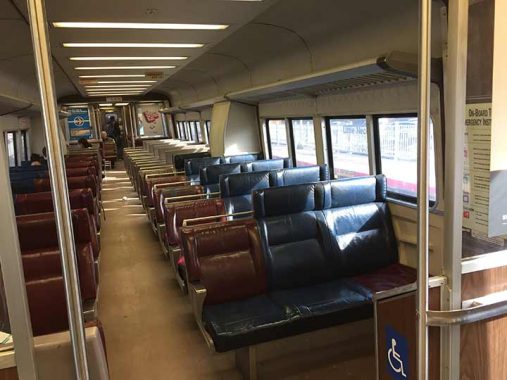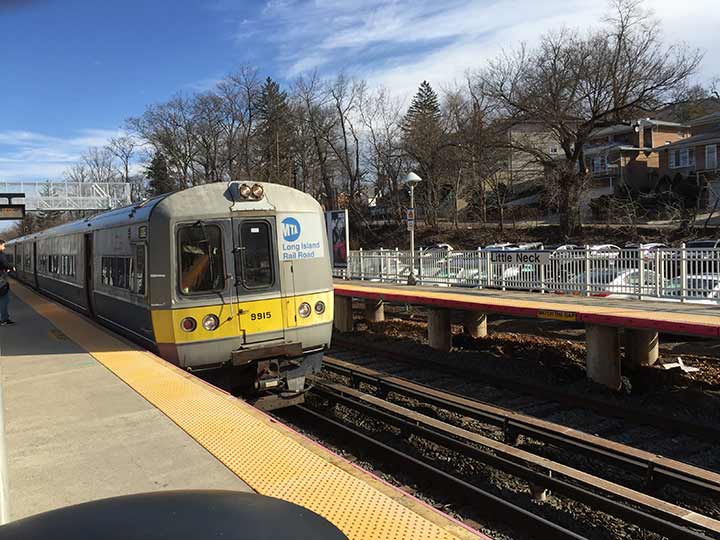
UNTIL just recently, M3 electric-powered rail cars employed on the Long Island Rail Road, were still in use as delivery of new M9 cars was delayed. (As MTA subway cars are prefixed with “R,” LIRR and Metro-North railcars are prefixed with “M.” I’m unsure what the initials stand for; Comments are open. (LIRR cars have odd numbers, Metro-North even.) R3 cars were introduced in the 1980s and ran along with M1s, introduced in the late 60s, at the same time for several decades, but M1s were retired a few years ago. Both M1s and M3s were similar in appearance, with a streamlined metal exterior and yellow trim. I was disappointed when the M7s, introduced around 2003, severely cut back on the yellow trim and M9s eliminated it completely, substituting a new MTA railcar color scheme of blue and gold.

Both M1s and M3s featured three-and two seating (I would never consent to sit in the center of the three-set, preferring to stand) in red and blue. After a few decades, the seats were repaired with duct tape and if you were especially unlucky, you sat in a non-upholstered seat and your rear sagged very deeply. Additionally, the LIRR gave up on repairing bathroom sinks and providing toilet paper: best to hold “number two” till you got home. Sitting near the restroom was to be avoided except at busy rush hours. As with today’s newer cars, the surfacing on the sunny-side windows got more and more opaque over time; I don’t know why the MTA doesn’t have an answer to this issue. Door openings were signaled by a loudly jangling bell.
Those cavils aside I miss the M3s. The seats were larger and more comfortable, and there was still an aura of old-time railroading; newer cars are quite bland and featureless in light blue.
As always, “comment…as you see fit.” I earn a small payment when you click on any ad on the site. Take a look at the new JOBS link in the red toolbar at the top of the page on the desktop version, as I also get a small payment when you view a job via that link.
12/4/23


12 comments
My beef with new railroads is that you can no longer open the windows.
“You might hurt yourself”
Welcome to the United Soviets of America, Chris, where everything has become bland, utilitarian, boring, and devoid of all charm and character. All of the fun and charm is long gone, and for all the purely utilitarian design, nothing actually works- much like the old USSR…..
You mention the even-number designs are for Metro North and the odd-number designs are for the LIRR. As for the individual cars themselves, they are usually found in pairs, with one of the pair housing the bathroom. How do you remember where you can find the bathroom on the train? Remember this, which it taught to first-responders in their training courses: “Odd car – odd smell”. Bathrooms are always in the odd-numbered car.
A few corrections and additions, if I may:
The “M” prefix for MTA electric rail cars was adapted in 1967, the year before the new M1 electric cars were initially put in service. “M” stands for two things. First, for Metropolitan, as in MTA, then a brand new NY State agency created to own and operate the LIRR. The M1 cars were unveiled as the dawn of a new era in commuter rail service, as they replaced a whole motley collection of old and obsolete rolling stock that dated back to 19-teens in some cases. The MTA wanted to project a new image for the LIRR, and the new M1 cars were the first concrete example of the changeover to public ownership.
Second, “M” also stands for “multiple unit” (MU) cars, meaning that each car in a train is equipped with its own electric motors. That said, a train can be any required length up to a certain maximum (LIRR is 12 cars) with one train operator controlling multiple cars simultaneously. This pioneering technology dates from 1897, when renowned inventor Frank Sprague first introduced his new idea on Chicago’s elevated lines. MU electric trains do not require an electric locomotive pulling or pushing the train, allowing the train to accelerate and brake more efficiently than a locomotive-powered train. Thus they are idea for high capacity commuter lines with frequent stops, such as LIRR and Metro-North, and justify the investment required for third rail or overhead wire electrification systems.
MU electric trains are used worldwide for all urban subways, and for many suburban and regional railroads. In the US, SEPTA in Philadelphia and NJ Transit both employ MU suburban trains, for example.
The LIRR M1 cars debuted in December 1968, and most were put in service between 1969 and 1972. All were retired between 2002 and 2006. The M3s, 174 cars total, were built 1985-87; today 100 remain on the active LIRR car roster. The Metro North M3s are of similar vintage, perhaps a year newer.
LIRR cars have both odd and even numbers, and are built as permanently coupled married pairs, meaning that in virtually all cases the numbers on each pair are consecutive; the even numbered car always faces east and is normally the higher value of the two. A few pairs are mismatched numbers because of past accidents and early car retirements. The individual cars cannot be operated independently because essential mechanical and electrical components are shared by both cars in a pair.
The operator’s cab is at the east end of the even# car, and the at west end of an odd# car. And that is why the south (sunny side) widows are always more opaque than their north side cousins. When an eastbound train leaves Penn or Grand Central or Brooklyn, the first car is always even-numbered. When the train is turned around at its eastern terminal and returns to NYC, the west car, an odd number, is always at the front. The cars are never looped because MU trains are like subways – the operator simply goes to the opposite end and takes it out from there. Thus the south side of the train (with the even# car always at the east end) is always facing that way, absorbing the sunlight.
What can the LIRR do about the windows? I notice even the M9 (“Emnine”) windows are getting affected. They could respond, “with onboard announcements and station indication readouts inside, you don’t have to look out the window.”
interesting
Many if the M1’s were financed by the Port Authority because the MTA did not have enough money
That was a well worded explanation. Thank you.
No toilet paper on LIRR trains?Just rip your sleeves off and use that to wipe
yourself.We learned that in Scouts.
Full disclosure: I have used the bathrooms on the M3’s. Only for #1, but still, they are for emergencies only.
I miss the bar car variations.
Ah I fondly remember ?? riding the old style LIRR cars. Rode them from 1994 to 2018. Serviceable transportation. Certainly, better than driving everyday back and forth to Manhattan. Don’t miss the days when there were service disruptions and trains would be cancelled and/or combined. Wow what a nightmare that was!